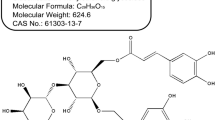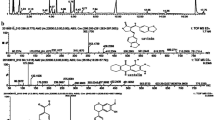Abstract
Carduus crispus, native to Europe and Asia, is a traditional herbal medicine used for treating inflammatory disorders in Korea. Obesity is characterized by a state of chronic inflammation with increased inflammatory markers along with the expression and release of inflammation-related adipokines. Most anti-obesity drugs have been developed based on this concept. Our research for anti-obesity agents derived from C. crispus utilized the 3T3-L1 cell line. The methanol extract was initially screened and exhibited significant inhibition of adipogenesis in 3T3-L1 adipocytes. Among five liquid–liquid partition fractions, the ethyl acetate (EA) fraction showed the most potent suppressive effect compared with hexane, chloroform, n-butanol, and water. The EA fraction was considered for further study because of the presence of abundant polyphenols, including flavonoids. To isolate the active components from the EA fraction, elution–extrusion countercurrent chromatography was used. Among the seven fractions from the EA layer, fraction 6 inhibited lipid accumulation as well as CCAAT/enhancer-binding protein alpha and peroxisome proliferator-activated receptor gamma protein expression levels. The active component apigenin (fraction 6) was confirmed using high-performance liquid chromatography, electrospray ionization mass spectrometry, and one-dimensional nuclear magnetic resonance spectroscopy. The present data suggest that apigenin is one of the main bioactive compounds from C. crispus for inhibiting adipogenesis in 3T3-L1 adipocytes via the activation of AMP-activated protein kinase.





Similar content being viewed by others
Abbreviations
- HSCCC:
-
High-speed countercurrent chromatography
- EECCC:
-
Elution–extrusion countercurrent chromatography
- CH:
-
Hexane-soluble layer of the methanol extract from C. crispus
- CC:
-
Chloroform-soluble layer of the methanol extract from C. crispus
- CE:
-
Ethyl acetate-soluble layer of the methanol extract from C. crispus
- CB:
-
n-Butanol-soluble layer of the methanol extract from C. crispus
- CW:
-
Water-soluble layer of the methanol extract from C. crispus
- DMI:
-
Cocktail of 1 μM dexamethasone, 0.5 mM IBMX, and 1 μg/mL insulin
References
Greenway FL, Smith SR (2000) The future of obesity research. Nutrition 16:976–982
Idogun ES, Unuigbe EI, Famodu AA, Akinola OT (2006) Body mass index in type 2 diabetes mellitus complications: hypertensive diabetics and diabetic nephropathy. Niger Postgrad Med J 13:17–20
Aggarwal BB (2010) Targeting inflammation-induced obesity and metabolic diseases by curcumin and other nutraceuticals. Annu Rev Nutr 30:173–199
Connolly HM, Crary JL, McGoon MD, Hensrud DD, Edwards BS, Edwards WD, Schaff HV (1997) Valvular heart disease associated with fenfluramine–phentermine. N Engl J Med 337:581–588
Padwal R, Li SK, Lau DC (2004) Long-term pharmacotherapy for obesity and overweight. Cochrane Database of Syst Rev CD004094
Kang JG, Park CY (2012) Anti-obesity drugs: a review about their effects and safety. Diabetes Metab J 36:13–25
Hargrave KM, Li CL, Meyer BJ, Kachman SD, Hartzell DL, Della-Fera MA, Miner JL, Baile CA (2002) Adipose depletion and apoptosis induced by trans-10, cis-12 conjugated linoleic acid in mice. Obes Res 10:1284–1290
Elkayam A, Mirelman D, Peleg E, Wilchek M, Miron T, Rabinkov A, Oron-Herman M, Rosenthal T (2003) The effects of allicin on weight in fructose-induced hyperinsulinemic, hyperlipidemic, hypertensive rats. Am J Hypertens 16:1053–1056
Hasegawa N, Yamda N, Mori M (2003) Powdered green tea has antilipogenic effect on Zucker rats fed a high-fat diet. Phytother Res 17:477–480
Wolfram S, Wang Y, Thielecke F (2006) Anti-obesity effects of green tea: from bedside to bench. Mol Nutr Food Res 50:176–187
Rayalam S, Della-Fera MA, Baile CA (2008) Phytochemicals and regulation of the adipocyte life cycle. J Nutr Biochem 19:717–726
Thielecke F, Boschmann M (2009) The potential role of green tea catechins in the prevention of the metabolic syndrome—a review. Phytochemistry 70:11–24
Zhang QY, Tu GZ, Zhao YY, Cheng TM (2002) Novel bioactive isoquinoline alkaloids from Carduus crispus. Tetrahedron 58:6795–6798
Jeong DM, Jung HA, Choi JS (2008) Comparative antioxidant activity and HPLC profiles of some selected Korean thistles. Arch Pharmacal Res 31:28–33
Lee EJ, Joo EJ, Hong YN, Kim YS (2011) Inhibition of adipocyte differentiation by MeOH extract from Carduus crispus through ERK and p38 MAPK pathways. Nat Prod Res 17:273–278
Eldahshan OA (2011) Isolation and structure elucidation of phenolic compounds of carob leaves grown in Egypt. Curr Res J Biol Sci 3:52–55
Rosen ED, Hsu CH, Wang X, Sakai S, Freeman MW, Gonzalez FJ, Spiegelman BM (2002) C/EBP α induces adipogenesis through PPARγ: a unified pathway. Genes Dev 16:22–26
Tontonoz P, Hu E, Spiegelman BM (1994) Stimulation of adipogenesis in fibroblasts by PPARγ2, a lipid-activated transcription factor. Cell 79:1147–1156
Ntambi JM, Young-Cheul K (2000) Adipocyte differentiation and gene expression. J Nutr 130:3122S–3126S
Bezy O, Vernochet C, Gesta S, Farmer SR, Kahn CR (2007) TRB3 blocks adipocyte differentiation through the inhibition of C/EBPβ transcriptional activity. Mol Cell Biol 27:6818–6831
Dagon Y, Avraham Y, Berry EM (2006) AMPK activation regulates apoptosis, adipogenesis, and lipolysis by eIF2α in adipocytes. Biochem Biophys Res Commun 340:43–47
Shukla S, Gupta S (2010) Apigenin: a promising molecule for cancer prevention. Pharm Res 27:962–978
McKay DL, Blumberg JB (2006) A review of the bioactivity and potential health benefits of chamomile tea (Matricaria recutita L.). Phytother Res 20:519–530
Shukla S, Gupta S (2004) Suppression of constitutive and tumor necrosis factor α-induced nuclear factor (NF)-κB activation and induction of apoptosis by apigenin in human prostate carcinoma PC-3 cells: correlation with down-regulation of NF-κB-responsive genes. Clin Cancer Res 10:3169–3178
Wang C, Kurzer MS (1997) Phytoestrogen concentration determines effects on DNA synthesis in human breast cancer cells. Nutr Cancer 28:236–247
Wang W, Heideman L, Chung CS, Pelling JC, Koehler KJ, Birt DF (2000) Cell-cycle arrest at G2/M and growth inhibition by apigenin in human colon carcinoma cell lines. Mol Carcinog 28:102–110
Acknowledgments
This work was supported by Grants (NRF-2013R1A1A2A10005492 and MRC 2009-93146) from the National Research Foundation of Korea.
Author information
Authors and Affiliations
Corresponding author
Ethics declarations
Conflict of interest
The authors declare no conflict of interest.
Compliance with ethics requirements
This article does not contain any studies with human or animal subjects.
Rights and permissions
About this article
Cite this article
Hong, Y.N., Chun, J. & Kim, Y.S. Anti-adipogenic activity of Carduus crispus and its constituent apigenin in 3T3-L1 adipocytes by downregulating PPARγ and C/EBPα. Eur Food Res Technol 242, 1555–1563 (2016). https://doi.org/10.1007/s00217-016-2656-6
Received:
Revised:
Accepted:
Published:
Issue Date:
DOI: https://doi.org/10.1007/s00217-016-2656-6




